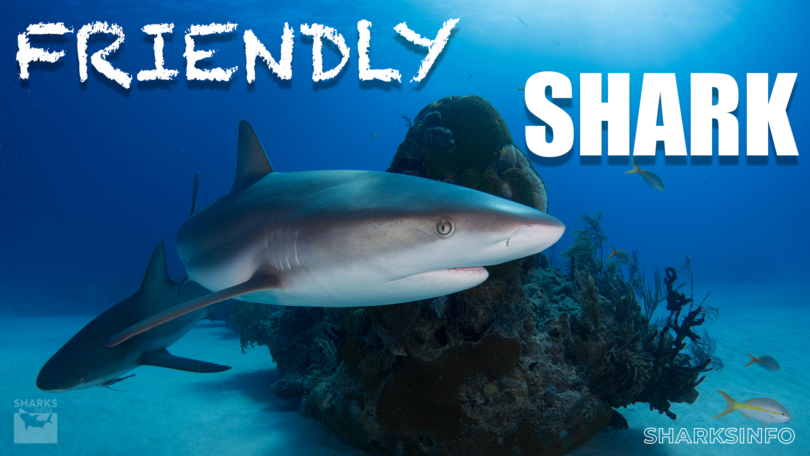There are almost 500 species of shark that have been around the world for hundreds of millions of years even before the existence of dinosaurs. Sharks are often perceived as deadly marine mammals, however, these oceanic creatures are not dangerous to humans. While few species of sharks are potentially harmful, some are known to interact with humans peacefully.
The behavior of sharks varies depending on the species; only when you swim with sharks you will realize they are not always dangerous. Some species are aggressive predators such as the Great White Shark. You will find some nicest, friendliest, and most beautiful sharks dwelling in the water. It is an unforgettable and enjoyable experience to swim with them.
In this comprehensive guide, we will discuss the following outline:
Can Sharks Be Friendly?
Yes, sharks can be friendly; some sharks pose a threat to humans but there are a lot of more species that are harmless. Despite their enormous size, sharp teeth, and scary looks, they rarely attack humans. The people are not on their menu; they mostly feed on fish and other marine mammals. The friendly and least dangerous sharks have smaller sizes and they tend to have docile temperaments. On the other hand, the sharks with maximum size such as the Great White Shark are more aggressive towards humans.

What Are the Most Friendly Sharks?
There are various types of sharks swimming in the ocean. Below we have listed the numerous sharks that are considered the most friendly sharks:
- Whale Shark
- Angel Shark
- Leopard Shark
- Nurse Shark
- Caribbean Reef Shark
- Basking Sharks
- Sand Tiger Shark
- Thresher Shark
- Bamboo Shark
- Cow Shark
- Catshark
1: Whale Shark
The Whale Sharks (Rhincodon typus) are one of the most friendly and massive sharks. These docile and beautiful species are not dangerous at all. They are considered a quiet gentle species as they are more tolerant towards divers. They engage with divers and provide them with the experience of swimming alongside sharks. They are known to interact and play with humans and allow swimmers to ride on their backs.
The Whale Sharks have a pattern of white stripes with dots over blue, gray, black, and brown bodies. They have an average length of 62 feet which is longer than the size of a school bus and weigh about 30 tons. They have 3000 tiny non-functional teeth which are less than 1 inch. These species are also known as filter-feeding species as they use the filters in their mouth to filter the plankton and zooplankton from the water.

2: Angel Shark
Angel Sharks are the most fascinating and beautiful creatures in oceans that belong to the genus Squatina. These 5 feet species are also referred to as the Sand Devils. The Angel Sharks are known for their flattened appearance similar to skates and rays. They have wide pectoral fins that run almost the entire length of their bodies, rather than just attached to the sides of the head. The Angel Sharks have large mouths and they live in the coastal water of the Atlantic and Pacific Oceans. They are among the deepest-dwelling sharks with a maximum depth of 4000 feet.
The Angel Sharks are a popular target for people interested in fishing and other game activities. They are not poisonous nor are they dangerous to humans. They are among the most friendly and gentle nature shark species. They are only known to attack or bite SCUBA divers if they are provoked. The natural defense mechanism is only to strike, however, the bites of these species are not usually severe.

3: Leopard Shark
The other least dangerous shark species is the Leopard Sharks (Triakis semifasciata). The grace and beauty of the motions of these species provide a thrilling experience to divers. They are harmless to humans and generally passive and friendly towards them; there is not a single report of these species attacking humans. They typically swim away from humans as they are scared of people. This does not mean they should be counted harmless as they have rows of powerful and sharp teeth that they use to defend themselves if they feel threatened.
The Leopard Sharks can grow up to a length of 4.9 feet. You can easily recognize these species from their sand-colored bodies with black dots. They have cylindrical bodies with elongated tails and large rounded pectoral fins. The Leopard Sharks live in shallow water and mostly dwell in more than 20 feet of water from the surface. They are rarely found on the passageways, coral reefs, and lagoons. They eat crabs and other small fishes in the ocean.

4: Nurse Shark
The Nurse Sharks or Sleeper Sharks (Ginglymostoma cirratum) are slow-moving bottom dweller sharks that are placed in the family Ginglymostomatidae. They have brown-colored bodies and have spots on the bodies of young sharks. The Nurse Sharks have round bodies with broad heads and triangular mouths. They have distinctive tail fins that are almost a quarter of their length. They have Jaws filled with thousands of tiny and serrated teeth.
The Nurse Sharks are slow-moving species and are the world’s laziest animals; these nocturnal species can grow up to 14 feet. These ferocious predators hang out alone at the bottom of the water and wait for the prey to pass through them.
The Nurse Sharks have a fearsome appearance. Despite this appearance, they are friendly towards humans and are considered one of the most harmless sharks worldwide. It is relatively safe to swim and interact with Nurse Sharks. They are not typically aggressive toward humans and no fatal attack has been recorded till now. However, they can bite people with their razor-sharp teeth, if they feel disturbed or threatened.

5: Caribbean Reef Shark
The Caribbean Reef Sharks or Reef Sharks (Carcharhinus perezii) are the most sophisticated apex predators of the reef ecosystem. They have a strong reputation for safety around humans that some ocean guides turned to feed them into a show. At the top of the food chain, they are one of the most interesting and intelligent sea creatures that dwell around the reef.
The Reef Sharks have gray sleek bodies with pointed strouts. You can distinguish them from their dusky-colored triangular extra tips on their dorsal fin. These species live in the warm waters of the Atlantic Ocean and can grow up to 6.5 to 10 feet. They mostly dwell close to the reefs and feed on small bony fish, cephalopods, and mollusks.
The Caribbean Reef Sharks are the most shy shark species that pose no threat to humans. They can attack and bite humans hard with their sickle-shaped teeth if they feel a threat or feel there is no escape route.

6: Basking Shark
Basking Sharks (Cetorhinus maximus) are the second largest fish species and are one of three plankton-eating filter-feeder species of sharks. They are one of the slow-moving species. They can reach up to a length of 26 feet. They have grayish-brown skin with a crescent-shaped caudal fin.
The Basking Sharks dwell in all the temperate waters of the world. They have a hundred rows of tiny teeth. They feed zooplanktons, fish, and small invertebrates by filtering them through the water with its mouth and gills.
The Basking Sharks are passive creatures and are not dangerous to humans. Despite their enormous size and threatening looks, they have never attacked humans or crushed animals using their teeth. The Basking Sharks are peaceful shark species that have no problem with boats and divers approaching them. They may even circle divers making them an important attraction for divers. But when they are harpooned, they can turn the boats or even attack the divers.

7: Sand Tiger Shark
The Sand Tiger Sharks have brownish-gray skins with rust-colored spots on their flattened bodies. These species have cone-shaped snouts. They can grow up to 11 feet. They prefer the water of the Pacific, Atlantic, and Indian oceans. The Sand Tiger Sharks feed on other fish and small sharks. They have quite several teeth at the corner of their mouth and their teeth stick out of their mouth even if it is closed.
The Sand Tiger Sharks are often perceived as fearsome creatures due to their large size and rows of sharp and pointed teeth. However, the Sand Tiger Sharks are friendly and often seen swimming with divers. These docile and non-aggressive species attack humans when they are bothered first or feel threatened. These species are equipped to inflict deep bites. There are only 36 record shark attacks of these species and none of them was fatal.

8: Thresher Shark
The Thresher Sharks (Alopias) are also known as Fox Sharks and you can easily identify these species from the large tails they use to stun their prey. They have torpedo-shaped bodies. The endothermic characteristics of these species make them agile hunters and quick swimmers. These species are found in the open and deep waters and are limited to the Indian and Pacific oceans. They can reach up to the height of 6m and mostly feed on other fish, crustaceans, and squids.
The Thresher Sharks are harmless to humans and are one of the friendly shark species; However, there is only one recorded attack of these species. The attack occurred after the diver grabbed the tail of the shark but fortunately, the attack was not serious and had no significant damage.

9: Bamboo Shark
The Bamboo Sharks (Chiloscyllium punctatum) are also known as longtail carpet sharks that spend most of their time walking on the seabeds. The Bamboo Sharks live in shallow waters and eat crustaceans, small fish, and mollusks. They do well in muddy and sandy conditions and enjoy the bottom to a depth of 280 feet. They have slender bodies, long thick tails, and a dorsal fin that is located opposite to the anterior of the fin base.
The Bamboo Sharks have a calm personality and they are harmless to humans. They are smaller in size and are non-aggressive sharks. These species are docile enough to interact and you can also pet them. They are 41 inches small species that can be kept in the 180-gallon aquarium. They are the best for the people who want diversity in their aquariums.

10: Cow Shark
The Cow Sharks (Hexanchidae) are a primitive shark species and are one of only two shark species with 7 gills. They can reach a length of 1.4 to 3.5 meters. These species have cylindrical bodies with a single dorsal fin to the back of their bodies. They have ventricle mouths with odd long and comb-like teeth. These species eat bony fish, sharks, and crustaceans.
Despite being the apex predators along with Great White Sharks, they are friendly sharks. The Cow Sharks are quite sluggish species and are not usually aggressive towards the divers. These inquisitive species rub up against SCUBA divers when they pass from them. Although they are placid, they should not be provoked. There are few non-deadly attacks recorded over the past few hundred years.

11: Catshark
Catsharks (Scyliorhinidae) are bottom-dwelling species and have a great variety of colors and sizes. These species have cylindrical-shaped bodies and cat-like eyes. The average measured size of Catsharks is 8 to 11 inches. They dwell in tropical and warm temperate regions. These species feed crabs, squids, and shrimp.
The Catsharks are friendly to others all the time and are harmless to humans. They may compete with each other aggressively for food. Just like other shark species they only attack humans if they are provoked or feel disturbed.

FAQs
1: Are Sharks friendly with humans?
Yes, most sharks are not dangerous to humans; despite their scary reputation, they only attack humans when they feel threatened. They feed on other marine animals and humans are not part of their diet. The most friendly shark species are Whale Shark, Nurse Shark, Basking Shark, Leopard Shark, Sand Tiger Shark, and many more.
2: Is it safe to be around Sharks?
No, do not enter into the water if the sharks are around, and leave the water quickly if the one is sighted.
3: Are there any peaceful sharks?
Yes, the Sand Tiger Sharks are peaceful. They are a slow-moving shark species that mostly dwell near the shore where they hunt the large school of fish.
4: What is the most playful shark?
The Porbeagle Sharks are the only known shark species engaged in playful behaviors. They have been seen pushing objects and chasing each other.
5: What is the safest shark to catch?
The Leopard Shark is the safest shark to catch as there is not a single report of attacking the shark on humans. They are rarely found in the 20 feet below the water surface and feed on small fish and crabs.
Conclusion
Sharks are amazing yet beautiful creatures of the ocean. They dwell in tropical and sub-tropical areas worldwide. They are often portrayed as the most dangerous and violent marine species that hunt and eat humans. Not all species are aggressive like the Great White Shark, the majority of shark species do not pose any threat to humans. Most sharks only attack or bite humans when they are curious or they feel threatened.
The most peaceful and friendly among all species is the Whale Shark. The other friendly and calm species that do not pose any threat to humans are the Leopard Shark, Basking Shark, Nurse Shark, Sand Tiger Shark, Cow Shark, Cat Shark, Caribbean Reef Shark, Angel Shark, and Bamboo Shark. We have discussed the details of these shark species in the above section of this guide.







